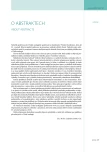Initial experience with intradetrusor application of botulinum A toxin in children with detrusor overactivity
Authors:
Pavel Zerhau; Matěj Husár
Authors‘ workplace:
Urologické oddělení Kliniky dětské chirurgie
ortopedie a traumatologie FN Brno
Published in:
Ces Urol 2009; 13(3): 207-210
Category:
Original article
Overview
Aim:
Publication of initial experience gained from mini-invasive treatment of children’s bladder overactivity by an intradetrusor application of botulinum A toxin.
Material and methods:
During 2007/2008, 6 children at the age from 5 to 12 years were treated by endoscopic application of botulinum A toxin into detrusor; an application of this method has always followed, when the conservative treatment failed. In two cases, the urinary detrusor hyperactivity was neurogenic; the other four patients have nonneurogenic origin of overactivity. The botulinum A toxin in a dose of 10 IU/kg complying with the children body weight was applied into 25 or 30 detrusor points. Upon the subsequent evaluation, continence effect, urodynamic parameters and duration effect were considered.
Results:
Five patients have shown an improvement of urinary continence. An enlargement of bladder capacity by 84% on the average was reached with all patients. In case of the 5 children, the intravesical pressure and non-inhibited contractions were reduced by 52% on the average. A maximum of improvement has appeared 3 months after the botulinumtoxin application, whereas lower values were recorded 6 or 9 months later.
Conclusion:
An application of botulinum A toxin represents a safe alternative treatment for children suffering from detrusor hyperactivity, caused by neurogenic or non-neurogenic genesis. A direct intra-detrusor-application of botulinum A toxin means a distinct decrease of the noninhibited contractions, reduction of the intravesical pressure, increase of the bladder capacity and improving of the urirary continence.
Key words:
neurogenic bladder, botulinum A toxin, detrusor overactivity, incontinence.
Sources
1. Dykstra DD, Sidi AA, Scott AB, et al. Effects of botulinum-A toxin on detrusor sphincter dyssynergia in spinal cord injury patients. J Urol 1988; 139: 919–922.
2. Schurch R, Stöhrer M, Kamer G, Schmidt DM, et al. Botulinum-A toxin for treating detrusor hyperreflexia in spinal cord injured patients – a new alternative to
anticholinergic drugs? Preliminary results. J Urol 2000; 164: 692–694.
3. Schulte-Baukloh H, Michael T, Schubert J, Stolze T, Knispel HH. Efficacy of botulinum-a toxin in children with detrusor hyperreflexia due to myelomeningocele: preliminary results. Urology 2002; 59: 325–327.
4. Krhut J, Mainer K, Kopecký J. Botulotoxin A – alternativa v léčbě hyperaktivního měchýře. Čes Urol 2004; 2: 19.
5. Krhut J, Kopecký J, Mainer K. Transuretrální injekce botulinumtoxinu v léčbě neurogenní hyperaktivity detruzoru. Čes Urol 2003; 1: 29.
6. Krhut J. Hyperaktivní močový měchýř. Praha: Jessenius Maxdorf 2007; 148 s.
7. Riccabona M, Koen M, Schindler M, Goedele B, et al. Botulinum-A toxin injection into the detrusor: a safe alternative in the treatment of children with myelomeningocele with detrusor hyperreflexia. J Urol 2004; 171: 845–848.
8. Altaweel W, Jednack R, Bilodeau C, Corcos J. Repeated intradetrusor botulinum toxin type A in children with neurogenic bladder due to myelomeningocele. J Urol 2006; 175: 1102–1105.
9. Chenet A, Perrouin-Verbe B, Le Normand L, Labat JJ, Brunel P, Lefort M, Mathé JF. Efficacy of repeat injections of botulinum A toxin to the detrusor in neurogenic bladder overactivity. Ann Readapt Med Phys 2007; 50(8): 651–660.
10. Hoebeke P, De Caestecker K, Vande Walle J, Dehoorne J, Raes A, Verleyen P, Van Laecke E. The effect of botulinum-A toxin in incontinent children with therapy resistant overactive detrusor. J Urol 2006; 176(1): 328–330.
Labels
Paediatric urologist Nephrology UrologyArticle was published in
Czech Urology

2009 Issue 3
Most read in this issue
- Ruptured kidney as complication of extracorporeal shock wave lithotripsy
- Our first experiences with thermo-expandable shape-memory Memokath stents
- BOTULINUM TOXIN: CURRENT USE IN UROLOGY
- Excursion to medical research information – impact factor and H-index
